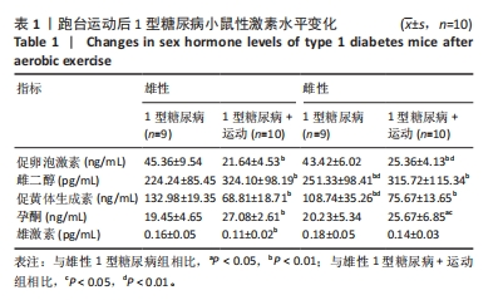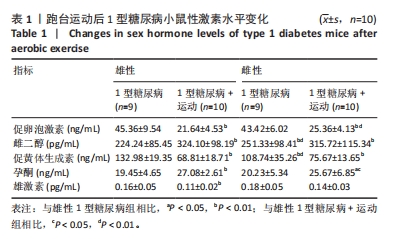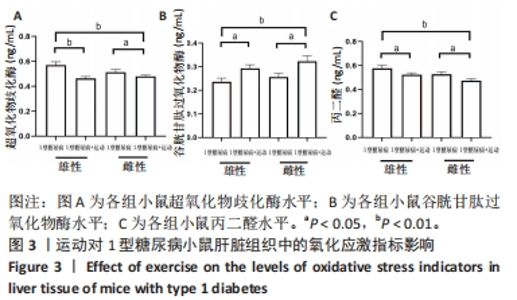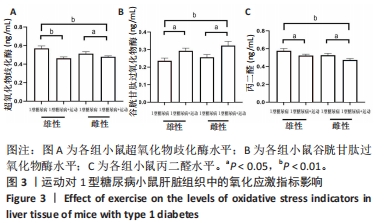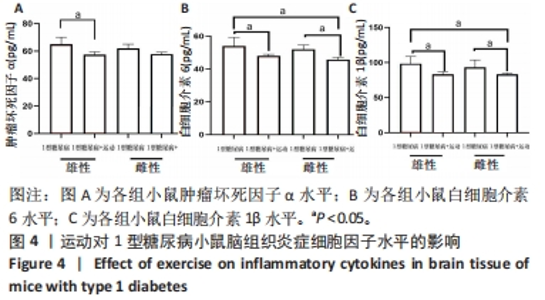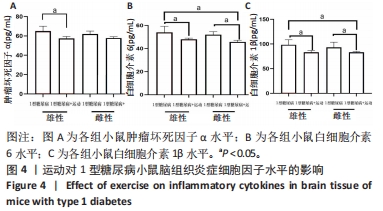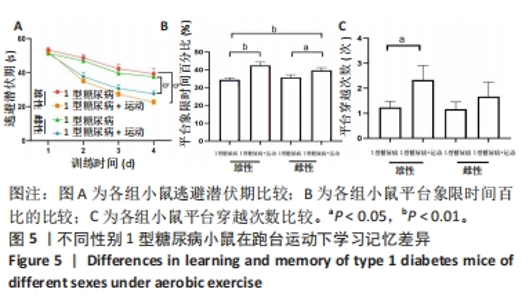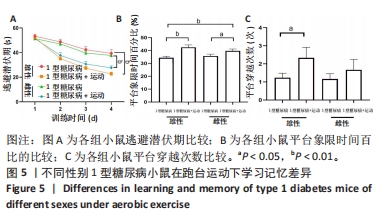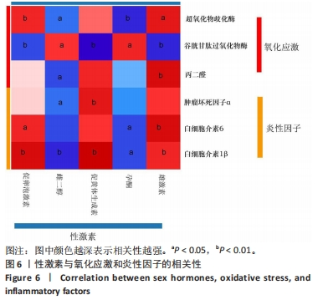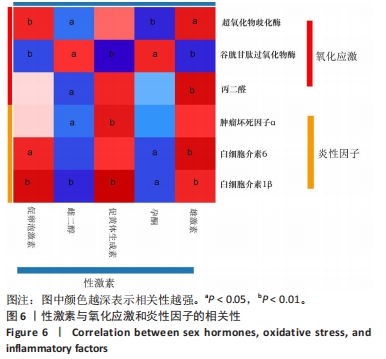Chinese Journal of Tissue Engineering Research ›› 2024, Vol. 28 ›› Issue (35): 5577-5583.doi: 10.12307/2024.804
Effects of treadmill exercise on metabolism and chronic neuroinflammation in type 1 diabetes mice of different sexes
Xie Yanli1, Wei Siang2, 3, Zhang Guodong1
- 1Department of Sports, 2School of Life Sciences, Shanxi Agricultural University, Jinzhong 030801, Shanxi Province, China; 3Fudan University Affiliated Zhongshan Hospital, Shanghai 200030, China
-
Received:2023-10-30Accepted:2023-12-26Online:2024-12-18Published:2024-03-15 -
Contact:Zhang Guodong, PhD, Lecturer, Department of Sports, Shanxi Agricultural University, Jinzhong 030801, Shanxi Province, China -
About author:Xie Yanli, Master, Lecturer, Department of Sports, Shanxi Agricultural University, Jinzhong 030801, Shanxi Province, China -
Supported by:Shanxi Education Science “14th Five-Year Plan” Project, No. GH-220131 (to XYL); Shanxi Provincial Funding for Scientific Research Projects of Returned Overseas Students, No. 2022-122 (to ZGD)
CLC Number:
Cite this article
Xie Yanli, Wei Siang, Zhang Guodong. Effects of treadmill exercise on metabolism and chronic neuroinflammation in type 1 diabetes mice of different sexes[J]. Chinese Journal of Tissue Engineering Research, 2024, 28(35): 5577-5583.
share this article
Add to citation manager EndNote|Reference Manager|ProCite|BibTeX|RefWorks
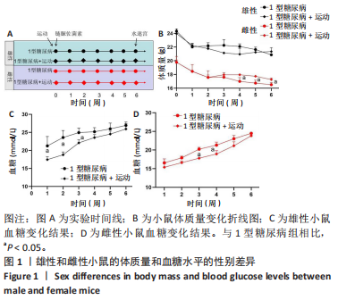
2.1 实验动物数量分析 实验共纳入小鼠40只,最终排除死亡和不符合血糖水平者,共纳入38只小鼠进入结果分析,其中雄性1型糖尿病组9只,雄性1型糖尿病+运动组10只,雌性1型糖尿病组9只,雌性1型糖尿病+运动组10只。 2.2 运动干预1型糖尿病的发展过程中,雄性和雌性小鼠的体质量和血糖水平的性别差异 按性别和运动锻炼将小鼠分别分为雄性:1型糖尿病组和1型糖尿病+运动组,雌性:1型糖尿病组和1型糖尿病+运动组,从链脲佐菌素注射到小鼠运动训练整个实验周期为6周,如图1A所示。注射链脲佐菌素后,雄性和雌性小鼠的体质量均显著下降(P < 0.01),在雄性小鼠中,与1型糖尿病组相比,1型糖尿病+运动组小鼠体质量几乎无差异;在雌性小鼠中,与1型糖尿病组相比,从第4周开始,1型糖尿病+运动小鼠体质量显著高于1型糖尿病组小鼠,见图1B。无论雄性还是雌性,1型糖尿病+运动组小鼠前期血糖均低于1型糖尿病组小鼠,后期血糖趋于一致,见图1C,D。"
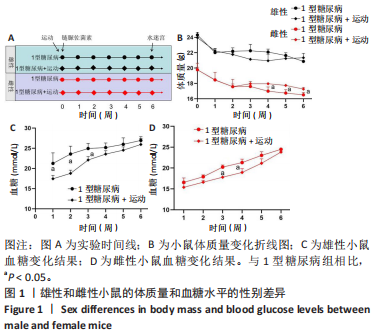
| [1] DIMEGLIO LA, EVANS-MOLINA C, ORAM RA. Type 1 diabetes. Lancet. 2018;391(10138):2449-2462. [2] LIN X, XU Y, PAN X, et al. Global, regional, and national burden and trend of diabetes in 195 countries and territories: an analysis from 1990 to 2025. Sci Rep. 2020;10(1):14790-14801. [3] XIA Y, XIE Z, HUANG G, et al. Incidence and trend of type 1 diabetes and the underlying environmental determinants. Diabetes Metab Res. 2019;35(1):e3075-e3097. [4] BISSON A, BODIN A, FAUCHIER G, et al. Sex, age, type of diabetes and incidence of atrial fibrillation in patients with diabetes mellitus: a nationwide analysis. Cardiovasc Diabetol. 2021;20(1):24-35. [5] SANTOS-MARCOS JA, MORA-ORTIZ M, TENA-SEMPERE M, et al. Interaction between gut microbiota and sex hormones and their relation to sexual dimorphism in metabolic diseases. Biol Sex Differ. 2023;14(1):4-28. [6] 冷思逸,蒲锐,陈子扬,等.运动干预肠道菌群对自身免疫性疾病的作用[J].中国组织工程研究,2023,27(32):5219-5226. [7] MAURICIO D, ALONSO N, GRATACÒS M. Chronic diabetes complications: the need to move beyond classical concepts. Trends Endocrin Met. 2020;31(4):287-295. [8] HAMED AE, ELSAHAR M, ELWAN NM, et al. Managing diabetes and liver disease association. Arab J Gastroenterol. 2018;19(4):166-179. [9] DUAN S, LI X, FAN G, et al. Targeting bile acid signaling for the treatment of liver diseases: from bench to bed. Biomed Pharmacother. 2022;152:113154. [10] NADERI R, POURHEYDAR B, GHIASI R, et al. Modulatory effect of tropisetron in the liver of streptozotocin-induced diabetes in rats: biochemical and histological evidence. Horm Mol Biol Clin Investig. 2020;41(3):1-7. [11] HOU Y, DING W, WU P, et al. Adipose-derived stem cells alleviate liver injury induced by type 1 diabetes mellitus by inhibiting mitochondrial stress and attenuating inflammation. Stem Cell Res Ther. 2022;13(1):132-148. [12] KOUNTOURI A, KORAKAS E, IKONOMIDIS I, et al. Type 1 diabetes mellitus in the SARS-CoV-2 pandemic: oxidative stress as a major pathophysiological mechanism linked to adverse clinical outcomes. Antioxidants (Basel). 2021;10(5):752-772. [13] EFTEKHARPOUR E, FERNYHOUGH P. Oxidative stress and mitochondrial dysfunction associated with peripheral neuropathy in type 1 diabetes. Antioxid Redox Signal. 2022;37(7-9):578-596. [14] LIU X, HUSSAIN R, MEHMOOD K, et al. Mitochondrial-endoplasmic reticulum rommunication-mediated oxidative stress and autophagy. Biomed Res Int. 2022;2022:6459585-6459597. [15] GARCIA WHITLOCK AE, SOSTRE-COLÓN J, GAVIN M, et al. Loss of FOXO transcription factors in the liver mitigates stress-induced hyperglycemia. Mol Metab. 2021;51:101246-101258. [16] SILVA AR, CERDEIRA CD, BRITO AR, et al. Green banana pasta diet prevents oxidative damage in liver and kidney and improves biochemical parameters in type 1 diabetic rats. Arch Endocrinol Metab. 2016;60(4):355-366. [17] DE ARAúJO BOLETI AP, DE OLIVEIRA FLORES TM, MORENO SE, et al. Neuroinflammation: an overview of neurodegenerative and metabolic diseases and of biotechnological studies. Neurochem Int. 2020;136: 104714-104780. [18] AMANOLLAHI M, JAMEIE M, HEIDARI A, et al. The dialogue between neuroinflammation and adult neurogenesis: mechanisms involved and alterations in neurological diseases. Mol Neurobiol. 2023;60(2):923-959. [19] VIRTUOSO A, DE LUCA C, KORAI SA, et al. Neuroinflammation and glial activation in the central nervous system: a metabolic perspective. Neural Regen Res. 2023;18(5):1025-1026. [20] SHALIMOVA A, GRAFF B, GĄSECKI D, et al. Cognitive dysfunction in type 1 diabetes mellitus. J Clin Endocrinol Metab. 2019;104(6):2239-2249. [21] CREO AL, CORTES TM, JO HJ, et al. Brain functions and cognition on transient insulin deprivation in type 1 diabetes. JCI Insight. 2021;6(5): e144014-e144026. [22] GHETTI S, KUPPERMANN N, REWERS A, et al. Cognitive function following diabetic ketoacidosis in young children with type 1 diabetes. Endocrinol Diabetes Metab. 2023;6(3):e412-e417. [23] GREEN A, HEDE SM, PATTERSON CC, et al. Type 1 diabetes in 2017: global estimates of incident and prevalent cases in children and adults. Diabetologia. 2021;64(12):2741-2750. [24] TRAMUNT B, SMATI S, GRANDGEORGE N, et al. Sex differences in metabolic regulation and diabetes susceptibility. Diabetologia. 2020; 63(3):453-461. [25] SHEPARD BD. Sex differences in diabetes and kidney disease: mechanisms and consequences. Am J Physiol Renal Physiol. 2019; 317(2):F456-F462. [26] LIU C, WU Y, ZHA S, et al. Treatment effects of tanshinone IIA against intracerebroventricular streptozotocin induced memory deficits in mice. Brain Res. 2016;1631:137-146. [27] MEMON B, ABDELALIM EM. Stem cell therapy for diabetes: beta cells versus pancreatic progenitors. Cells. 2020;9(2):283-295. [28] MAAHS DM, WEST NA, LAWRENCE JM, et al. Epidemiology of type 1 diabetes. Endocrin Metab Clin. 2010;39(3):481-497. [29] RUSSO G, MANICARDI V, ROSSI M, et al. Sex-and gender-differences in chronic long-term complications of type 1 and type 2 diabetes mellitus in Italy. Nutr Metab Cardiovasc. 2022;32(10):2297-2309. [30] CHALAKOVA T, YOTOV Y, TZOTCHEV K, et al. Type 1 diabetes mellitus-risk factor for cardiovascular disease morbidity and mortality. Curr Diabetes Rev. 2021;17(1):37-54. [31] VAN VELZEN D, WIEPJES C, NOTA N, et al. Incident diabetes risk is not increased in transgender individuals using hormone therapy. J Clin Endocrinol Metab. 2022;107(5):e2000-e2007. [32] BRINKMANN C. Road map for personalized exercise medicine in T2DM. Trends Endocrinol Metab. 2023;34(12):789-798. [33] 刘晓晨,王改凤,张社峰.有氧运动可改善糖尿病肾病模型小鼠肾脏的氧化应激损伤[J].中国组织工程研究,2020,24(17):2712-2717. [34] FULGHUM K, COLLINS HE, JONES SP, et al. Influence of biological sex and exercise on murine cardiac metabolism. J Sport Health Sci. 2022;11(4):479-494. [35] HUGENSCHMIDT CE, DURAN T, ESPELAND MA. Interactions between estradiol, diabetes, and brain aging and the risk for cognitive impairment. Climacteric. 2021;24(4):359-365. [36] VOUTSADAKI K, MATALLIOTAKIS M, LADOMENOU F. Hypogonadism in adolescent girls: treatment and long-term effects. Acta Biomed. 2022;93(5):e2022317-e2022328. [37] SANTORO A, MELE E, MARINO M, et al. The complex interplay between endocannabinoid system and the estrogen system in central nervous system and periphery. Int J Mol Sci. 2021;22(2):972-997. [38] MICHAEL OS, OLATUNJI LA. Ameliorative effect of nicotine exposure on insulin resistance is accompanied by decreased cardiac glycogen synthase kinase-3 and plasminogen activator inhibitor-1 during oral oestrogen-progestin therapy. Arch Physiol Biochem. 2018;124(2):139-148. [39] BACON JL. The menopausal transition. Obstet Gyn Clin. 2017;44(2):285-296. [40] PASUPULETI VR, ARIGELA CS, GAN SH, et al. A review on oxidative stress, diabetic complications, and the roles of honey polyphenols. Oxid Med Cell Longev. 2020;2020:8878172-8878188. [41] INCALZA MA, D’ORIA R, NATALICCHIO A, et al. Oxidative stress and reactive oxygen species in endothelial dysfunction associated with cardiovascular and metabolic diseases. Vascul Pharmacol. 2018;100:1-19. [42] RASOOLIJAZI H, NOROUZI OFOGH S, ABABZADEH S, et al. Comparing the effects of rosemary extract and treadmill exercise on the hippocampal function and antioxidant capacity in old rats. Basic Clin Neurosci. 2021;12(3):361-372. [43] ALMOUSA LA, ALFARIS NA, ALSHAMMARI GM, et al. Rumex nervosus could alleviate streptozotocin-induced diabetic nephropathy in rats by activating Nrf2 signaling. Sci Prog. 2022;105(2):368504221102751-368504221102774. [44] SHI J, FAN J, SU Q, et al. Cytokines and abnormal glucose and lipid metabolism. Front Endocrinol. 2019;10:703-719. [45] YANG Y, KLIONSKY DJ. A novel role of ATG9A and RB1CC1/FIP200 in mediating cell-death checkpoints to repress TNF cytotoxicity. Autophagy. 2023;19(6):1617-1618. [46] GODFREY MS, FRIEDMAN LN. Tuberculosis and biologic therapies: anti-tumor necrosis factor-α and beyond. Clin Chest Med. 2019;40(4):721-739. [47] DONG J, ZUO Z, YAN W, et al. Berberine ameliorates diabetic neuropathic pain in a rat model: involvement of oxidative stress, inflammation, and μ-opioid receptors. Naunyn Schmiedebergs Arch Pharmacol. 2019;392(9):1141-1149. [48] MENDIOLA AS, CARDONA AE. The IL-1β phenomena in neuroinflammatory diseases. J Neural Transm. 2018;125:781-795. [49] SONG H, YANG B, LI Y, et al. Focus on the mechanisms and functions of pyroptosis, inflammasomes, and inflammatory caspases in infectious diseases. Oxid Med Cell Longev. 2022;2022:2501279-2501300. |
| [1] | Yang Yifeng, Ye Nan, Wang Lin, Guo Shuaicheng, Huang Jian. Signaling pathway of dexmedetomidine against ischemia-reperfusion injury [J]. Chinese Journal of Tissue Engineering Research, 2024, 28(9): 1464-1469. |
| [2] | Zhao Garida, Ren Yizhong, Han Changxu, Kong Lingyue, Jia Yanbo. Mechanism of Mongolian Medicine Erden-uril on osteoarthritis in rats [J]. Chinese Journal of Tissue Engineering Research, 2024, 28(8): 1193-1199. |
| [3] | Wang Ji, Zhang Min, Li Wenbo, Yang Zhongya, Zhang Long. Effect of aerobic exercise on glycolipid metabolism, skeletal muscle inflammation and autophagy in type 2 diabetic rats [J]. Chinese Journal of Tissue Engineering Research, 2024, 28(8): 1200-1205. |
| [4] | Lou Guo, Zhang Yan, Fu Changxi. Role of endothelial nitric oxide synthase in exercise preconditioning-induced improvement of myocardial ischemia-reperfusion injury [J]. Chinese Journal of Tissue Engineering Research, 2024, 28(8): 1283-1288. |
| [5] | Pan Xiaolong, Fan Feiyan, Ying Chunmiao, Liu Feixiang, Zhang Yunke. Effect and mechanism of traditional Chinese medicine on inhibiting the aging of mesenchymal stem cells [J]. Chinese Journal of Tissue Engineering Research, 2024, 28(7): 1091-1098. |
| [6] | Lan Yao, Chen Liuyang, Song Wenhui. Key biomarkers for the diagnosis of intervertebral disc degeneration associated with oxidative stress: identification based on bioinformatics and machine learning [J]. Chinese Journal of Tissue Engineering Research, 2024, 28(35): 5591-5597. |
| [7] | Hong Weihao, Tian Hang, Luan Yisheng, Ma Yixuan, Xiong Yingzhe, Zhang Bing. Effects of moderate-intensity continuous training and high-intensity interval training on obesity-related muscle atrophy in mice [J]. Chinese Journal of Tissue Engineering Research, 2024, 28(35): 5618-5623. |
| [8] | Tang Lulu, Pan Xiaojia, Lai Yingtao, Wang Li. Regulatory mechanism of ferroptosis on pressure ulcers: bioinformatics analysis and experimental validation [J]. Chinese Journal of Tissue Engineering Research, 2024, 28(35): 5656-5661. |
| [9] | Wang Yueguang, Mu Xiaohong, Jiang Shengyuan, Deng Bowen, Kang Ximei, Su Jianguang. Correlation between early serum markers and AISA grading in patients with acute spinal cord injury [J]. Chinese Journal of Tissue Engineering Research, 2024, 28(34): 5494-5499. |
| [10] | Wu Yuwei, Zhu Jiang, Zheng Bing, Wu Zonghui. Mechanism by which exercise controls uric acid level [J]. Chinese Journal of Tissue Engineering Research, 2024, 28(34): 5552-5557. |
| [11] | Dong Gengxin, Li Yiting, Hong Yinglu, Bao Dapeng. Effect of hydrogen-rich gas on proprioception and muscle endurance after high-intensity exercise [J]. Chinese Journal of Tissue Engineering Research, 2024, 28(34): 5413-5418. |
| [12] | Yu Guangwen, Xie Junjie, Liang Jiajian, Liu Wengang, Wu Huai, Li Hui, Hong Kunhao, Li Anan, Guo Haopeng. Role and significance of deep learning in intelligent segmentation and measurement analysis of knee osteoarthritis MRI images [J]. Chinese Journal of Tissue Engineering Research, 2024, 28(33): 5382-5387. |
| [13] | Lu Xiaoling, Liu Bin, Xu Bin. Bioinformatics identification and validation of genes related to fatty acid metabolism in rheumatoid arthritis [J]. Chinese Journal of Tissue Engineering Research, 2024, 28(32): 5116-5121. |
| [14] | Ren Weiliang, Jiao Yongwei, Zhang Jian, Yang Liying, Yang Qi. Modulatory effect of resveratrol on oxidative stress and inflammatory factors in the joint fluid of rats with knee osteoarthritis [J]. Chinese Journal of Tissue Engineering Research, 2024, 28(32): 5154-5158. |
| [15] | Xu Rui, Li Yanyan, Xu Hong. Effect and mechanism of short-chain fatty acids in aged rats with sarcopenia [J]. Chinese Journal of Tissue Engineering Research, 2024, 28(32): 5172-5176. |
| Viewed | ||||||
|
Full text |
|
|||||
|
Abstract |
|
|||||


